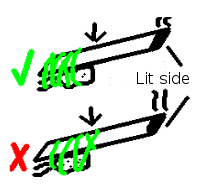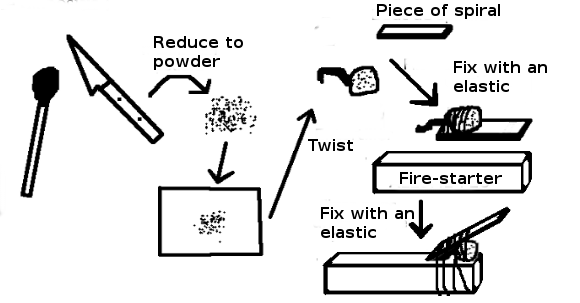1. Notes on security
The devices described here can leave traces, all the more so if they don’t ignite. Thus, all manipulations need to be done in a clean environment, with a pair of one-use dishwashing gloves, while covering your mouth and hair, using a clean garbage bag spread out as a work space, and while wearing a k-way type tracksuit (where hair of any sort won’t cling to it).1 The device can be stored in a garbage bag or a freezer bag before removing your gloves, to transport it. If the material is bought, don’t buy everything at the same place and paying in cash could be a good idea. Lastly, in the case of a raid, it’s better to be rid of the material and packaging before use.
Lastly, do several tests before using it for real, to be sure that the brands of different materials work well together and to avoid bad surprises!
2. With magic candles
Ingredients:
- fire-starter
- magic birthday candles (that re-light)
With the support of the candle or with a clean knife, make a hole corresponding to the diameter of the candle in the fire-starter, and stick the candle in it such that it doesn’t move.
After lighting it, you must in general wait around twenty seconds before the interior filaments are lit and that they will re-light if they extinguish.
Small sparks are given off by candle once it is lit. This device is very simple to make, but it is bright and thus easy to notice, by a passerby for instance.
You can count on 5/6 minutes of delay, before the fire-starter cube lights in turn and sets the rest of the incendiary device alight.
3. With anti-mosquito spirals/incense stick
Ingredients:
- fire-starter in individual packaging with easy lighting
- 5/6 matches
- cellophane
- small elastics2
- a stick of incense, or a 4/5 cm piece of anti-mosquito spiral
With a knife, remove the sulfur from the matches while avoiding adding wood shavings, and reduce it to a powder (by wrapping it in paper and crushing it with a knife handle, for example).
Put the sulfur in the middle of a square of cellophane and form a tight ball, by twisting the cellophane well. Fix this ball well to the incense stick or the anti-mosquito spiral with an elastic, ensuring that the ball is well stuck, and that the ball isn’t surrounded by elastic all the way until the end (illustration below) – it’s necessary that the ember of the spiral is first in contact with the sulfur, otherwise there is a risk that the device will come undone before igniting.

With another elastic, fix this construction onto the fire-starter, sulfur in contact with the fire-starter.
This device allows an adequately long delay, depending on the length of the spiral/incense before the sulfur: one could do tests to evaluate the time that is obtained. It is also more discreet: there is not a flame before the trigger, but just a small ember and a thin trail of smoke. But it is also more complex and can thus necessitate testing it multiple times before using it, with perhaps different brands for the incense, cellophane and/or matches, and with the amount of manipulations, it’s very important to pay attention to not leave a trace. After lighting it, do not blow on it to extinguish the flame, but shake the device!

[Notes from Warrior Up:
– You can use multiple delays per incendiary device, so that if one fails the rest of the incendiary device still has a chance to ignite.]
Translated from Attaque
- See DNA You Say? for more information on setting up a clean environment. ↵
- We recommend instead using cable ties because elastics are more liable to fly out of the burning area when they rupture. ↵
